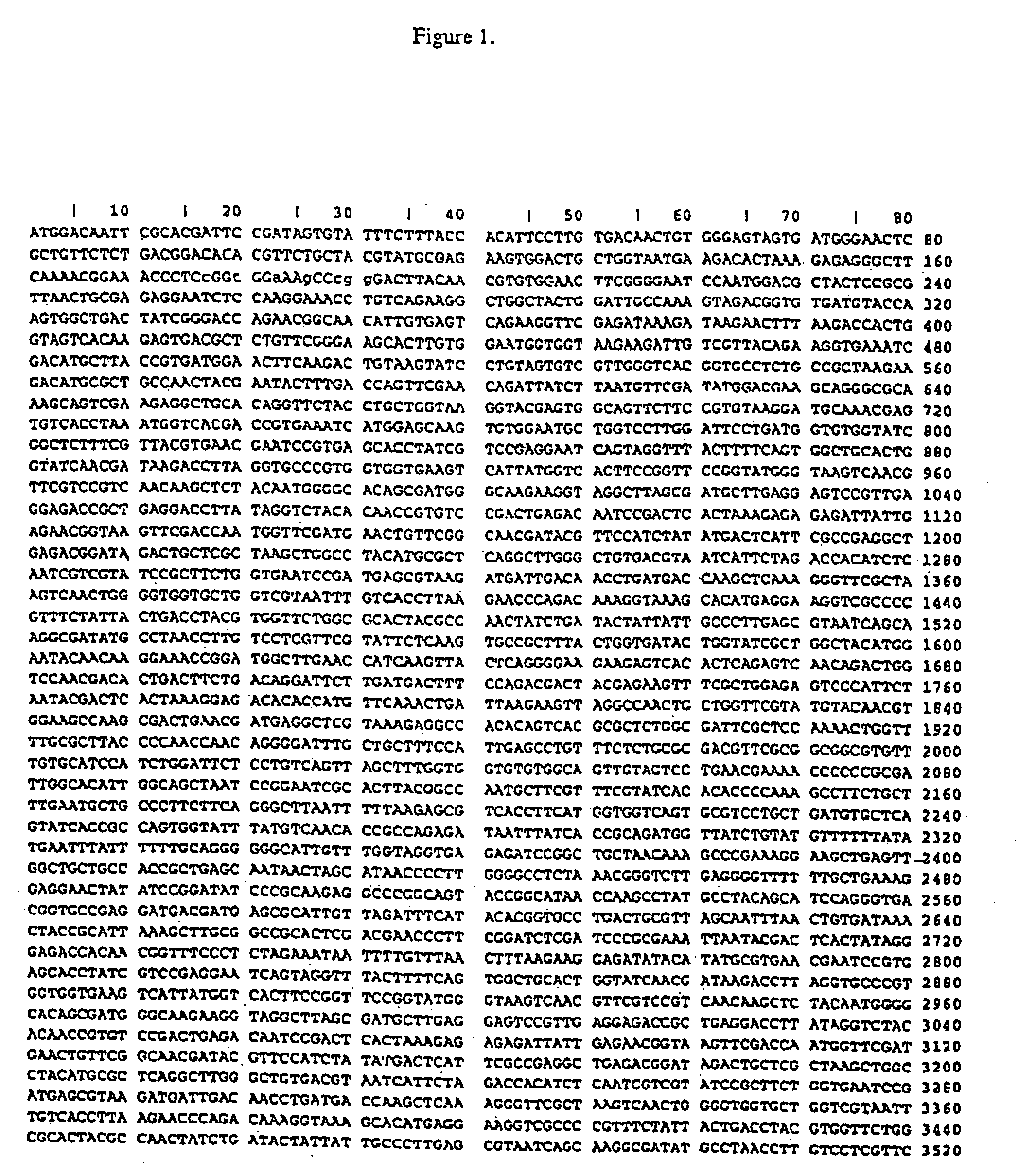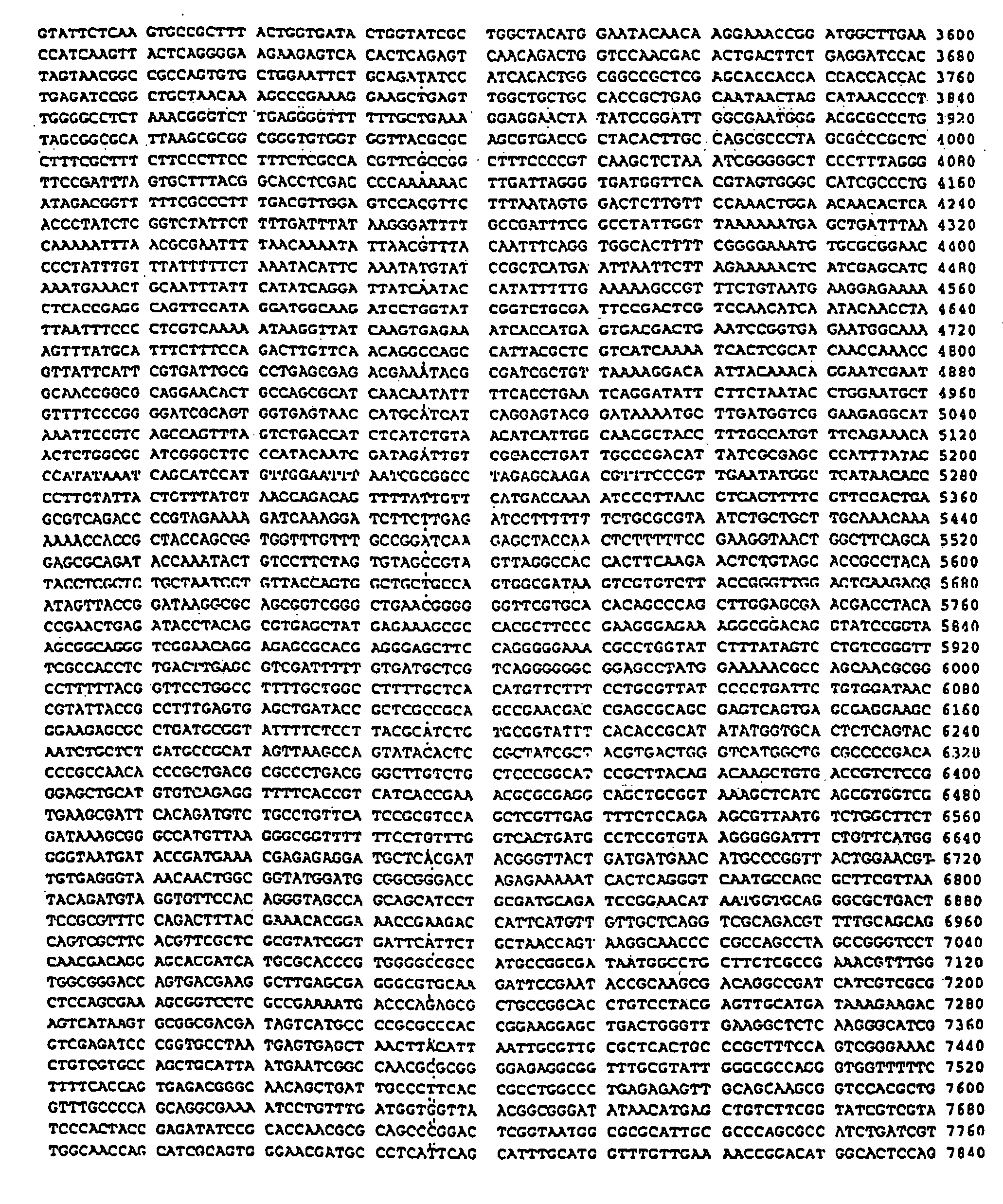Isothermal amplification of DNA
- Summary
- Abstract
- Description
- Claims
- Application Information
AI Technical Summary
Benefits of technology
Problems solved by technology
Method used
Image
Examples
example 1
Amplification of Purified Plasmid DNA Using a Minimal Number of T7 Replication Proteins
[0069] The reaction mixture (45 μl) contains 20 mM Tris-glutamate, pH 7.5, 9 mM MgCl2, 6 mM dithiothreitol, 100 mM potassium glutamate, 3.5% dimethylsulfoxide (DMSO), 7% Dextran T-500 polysaccharide (Amersham Pharmacia Biotech, Inc., Piscataway, N.J.), 550 μM each dGTP, dATP, dTTP and dCTP, 330 μM ATP, 440 μM CTP, and DNA. The DNA samples range from 0.1 pg to 10 ng of supercoiled double-stranded plasmid DNA.
[0070] Although circular DNA is a preferred substrate for amplification, linear DNA can also be used. The DNA can be either single- or double-stranded. In addition to plasmid DNA, other DNAs such as phage lambda DNA, phage M13 DNA bacterial artificial chromosomal (BAC) DNA and genomic DNA (e.g., bacterial or human) are effective templates for amplification. Synthetic DNA such as oligonucleotides 100 nucleotides in length can be used if they are first ligated to form circular molecules. Data s...
example 2
Amplification of Purified Plasmid DNA Using a T7 Replication System Optimized for Maximum Rate and Amount of DNA Synthesis
[0078] The rate and amount of DNA synthesis obtained using the conditions defined in Example 1 can be improved by using the modifications described below. All other components and conditions are identical to those outlined in Example 1.
[0079] Phosphocreatine (11 mM) is added to the 45 μl reaction mixture. This in combination with creatine kinase provides an efficient ATP regeneration system. The phosphocreatine that is most effective is synthetic phosphocreatine, Sigma catalog number P6502 (Sigma Chemical Co., St. Louis, Mo.), dissolved in H2O to a concentration of 500 mM.
[0080] The enzyme mixture contains at least some of the following six enzymes. These are in addition to the Δ28 T7 DNA polymerase, native T7 DNA polymerase, 63-kDa gene 4 protein and E. coli single-stranded DNA binding protein, which are present in the amounts defined in Example 1.
[0081] (1)...
example 3
Assay to Determine Whether Amplification is Exponential
[0089] Reactions as described in Examples 1 and 2 are carried out using varying amounts of plasmid DNA and for varying lengths of time. A radioactively labeled dNTP is used in order to determine the amount of DNA synthesis; for example, 50 cpm / pmole [3H]dTTP or [α-32P]dATP. 100 μl reactions are carried out in the absence of added DNA, and in the presence of 1, 10, 100 and 1,000 pg of supercoiled pUC18 plasmid DNA. Reactions are carried out at 37° C. and 20 μl aliquots are removed at 5, 10, 15, 20 and 30 min and stopped by the addition of 5 μl of 200 mM EDTA, pH 8.0. The amount of radioactivity incorporated into DNA is determined using standard methods. For example, the amount of radioactivity that can be precipitated by trichloracetic acid, which will precipitate DNA but not free nucleotide, can be determined as described in Tabor and Richardson, J. Biol. Chem. 264:6647, 1989. Alternatively, the amount of radioactivity that is ...
PUM
| Property | Measurement | Unit |
|---|---|---|
| Temperature | aaaaa | aaaaa |
Abstract
Description
Claims
Application Information
 Login to View More
Login to View More - R&D
- Intellectual Property
- Life Sciences
- Materials
- Tech Scout
- Unparalleled Data Quality
- Higher Quality Content
- 60% Fewer Hallucinations
Browse by: Latest US Patents, China's latest patents, Technical Efficacy Thesaurus, Application Domain, Technology Topic, Popular Technical Reports.
© 2025 PatSnap. All rights reserved.Legal|Privacy policy|Modern Slavery Act Transparency Statement|Sitemap|About US| Contact US: help@patsnap.com



